29.11.2022
China reveals the 3 astronauts flying on Shenzhou 15 space station mission
The crew includes two rookies and one veteran with just five days of spaceflight experience.
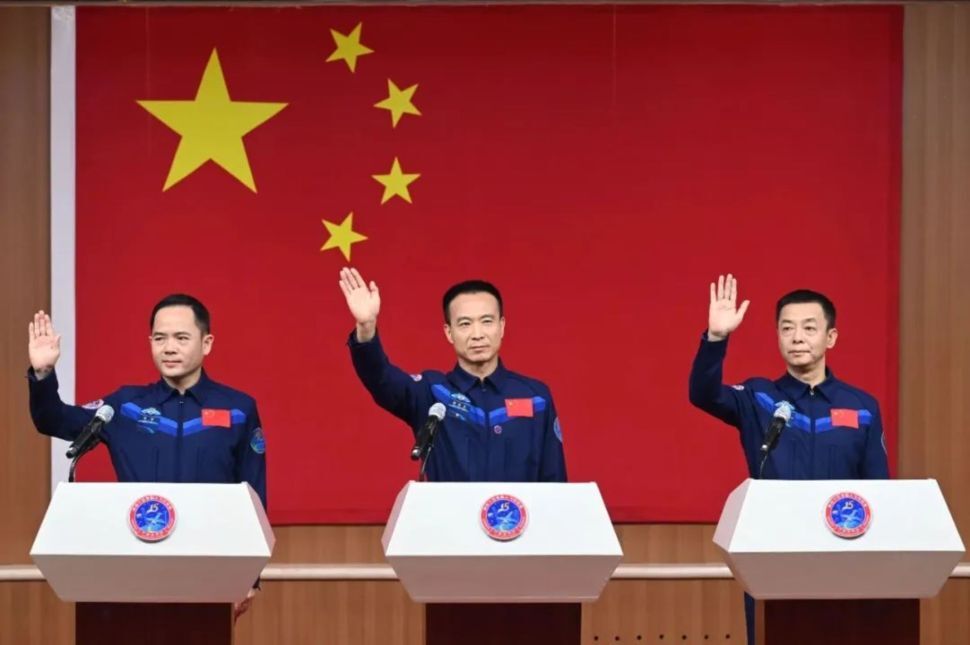
Commander Fei Junlong (center), Zhang Lu (left) and Deng Qingming (right) at a Shenzhou 15 pre-launch press conference at Jiuquan on Nov. 28, 2022. (Image credit: Ourspace)
China just unveiled the crew that will launch on its Shenzhou 15 mission Tuesday (Nov. 29) and spend the next six months in space.
Commander Fei Junlong and crewmates Deng Qingming and Zhang Lu met the press on Monday (Nov. 28), just a day before the scheduled launch of their spacecraft from Jiuquan in the Gobi Desert. China’s human spaceflight agency, CMSA, is run by the country’s military and typically keeps the identity of its crews secret until close to launch.
Shenzhou 15's launch on a Long March 2F rocket is set for Tuesday at 10:08 a.m. EST (1508 GMT; 11:08 p.m. local time). You can watch it live here at Space.com, courtesy of CCTV; coverage begins at 6:30 a.m EST (1130 GMT).
The trio will fly to the recently completed Tiangong space station. They will join the Shenzhou 14 astronauts aboard Tiangong and complete China’s first-ever and highly anticipated crew handover in orbit.
Commander Fei Junlong, 57, is making his return to space after a 17-year wait. Fei was selected among China’s first batch of astronauts in 1998 and commanded the five-day-long Shenzhou 6 mission in 2005.
Deng Qingming, 56, was also chosen to be a member of the first generation of astronauts but has needed to wait a long time for his opportunity to fly to space.
"As an astronaut, my normal shape is to stay committed to the original aspiration of spaceflight missions and never stop training, which is also my attitude," Deng said(opens in new tab) during the Nov. 28 press conference at Jiuquan.
"For me, I can spend my whole life getting prepared silently, but I will never allow myself to be unprepared when the task comes by," said Deng.
Zhang Lu, 46, is also making his first trip to space and is part of China's second batch of astronauts selected in May 2010.
"I'm looking forward to experiencing the wonderful feeling in zero gravity and to completing our space home with our own hands," Zhang said.
The Shenzhou 15 crew — all of whom enjoy calligraphy as a hobby, according(opens in new tab)to Chinese media — will spend six months in space conducting a range of experiments and maintaining the space station.
Quelle: SC
+++
Three Chinese astronauts ready for flight to Tiangong space station
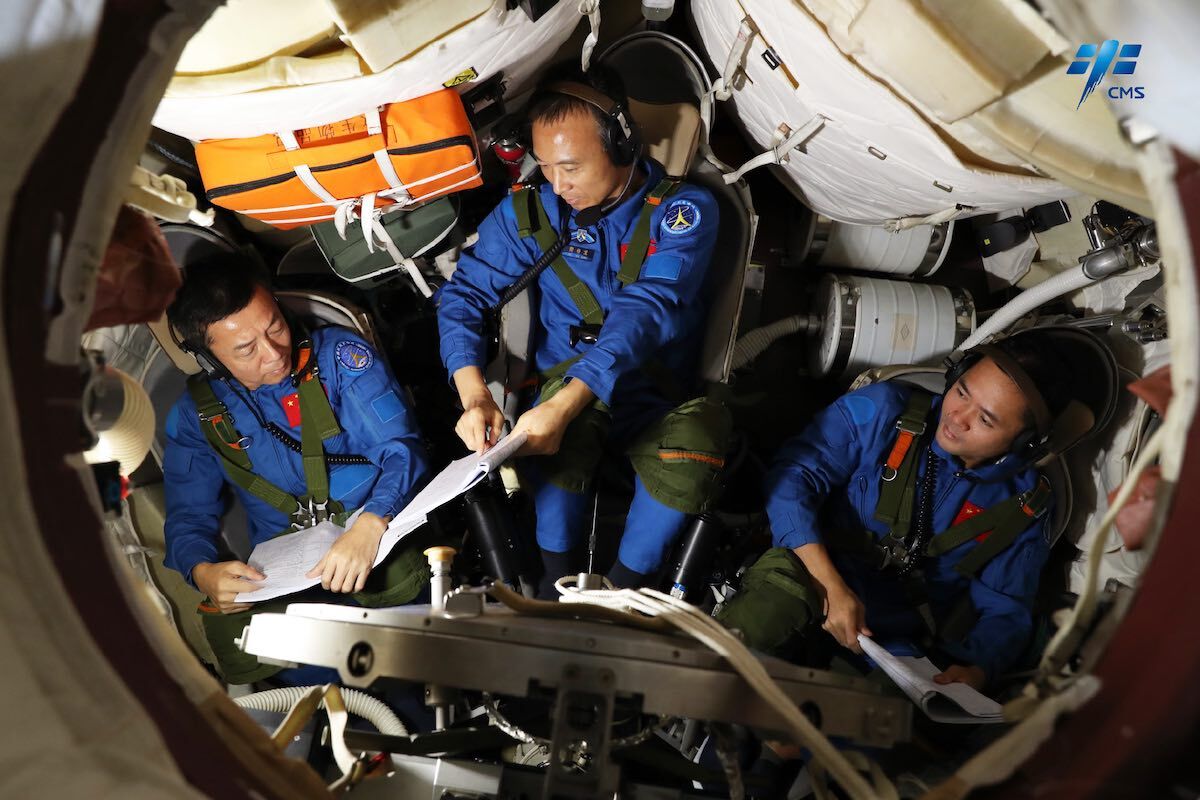
Chinese astronauts Deng Qingming, Fei Junlong, and Zhang Lu (left to right) undergo training before launch on the Shenzhou 15 mission. Credit: China Manned Space Agency
Three Chinese astronauts will strap into a Shenzhou spacecraft and rocket into orbit Tuesday in pursuit of China’s Tiangong space station on a six-month mission to transition the space lab from construction into an operational phase.
Veteran commander Fei Junlong will be joined by rookie astronauts Deng Qingming and Zhang Lu for liftoff at 10:08 a.m. EST (1508 GMT) from the Jiuquan launch base, a remote military-run spaceport in the Gobi Desert of northwestern China.
Freezing temperatures are forecast for the launch, which is scheduled for 11:08 p.m. Beijing time, when the Earth’s rotation brings the Jiuquan launch site underneath the orbital plane of the Tiangong space station. None of China’s astronaut missions have launched so late in the year. China’s nine crew launches since the country’s first human spaceflight in 2003 have blasted off in June, September, or October.
The China Manned Space Agency said ground equipment at the launch site was “completely updated and modified” to better withstand the cold temperatures. Engineers have developed procedures to ensure propellant tanks remain at proper temperatures during the countdown, and added insulation to specific sections of the rocket.
Chinese officials revealed the identities of the astronauts on the Shenzhou 15 mission Monday. In contrast to the U.S. and Russian space programs, China typically keeps its crew assignments secret until the day before launch.
Fei, 57, commanded the Shenzhou 6 mission in 2005, China’s second crewed flight to low Earth orbit. He spent nearly five days in orbit, and is ready to launch into space again more than 17 years later.
“Today, I am very proud and excited to be able to go to space again for my country,” Fei said in brief remarks to news media gathered at the Jiuquan launch site. “Especially when we are about to enter our own Chinese space station, I am deeply proud and proud of our great motherland.”

“The Shenzhou 15 mission is not only the last of the construction period of China’s space station, but also the beginning of the next new stage,” Fei said. “During the half-year flight, we will conduct more on-orbit tests, and the operation, maintenance and repair of equipment.”
Chinese officials said the Shenzhou 15 astronauts will head outside the Tiangong space station for three or four spacewalks to complete tasks that Fei described as “more arduous” and “more complicated” than previous Chinese spacewalks.
“Therefore, we have carried out a lot of targeted training on the ground,” said Fei, a major general in the Chinese Air Force. “Through the training, we also have enough confidence to complete this key link between the past and the future.”
Fei and his crewmate Deng Qingming, a 56-year-old former Chinese Air Force fighter pilot, were selected in China’s first class of astronauts in 1998. But Deng had to wait a quarter-century for his first flight to space.
“We deeply know that it is thousands of aerospace science and technology workers who support us to fly,” Deng said. “Here, I would like to pay tribute to all Chinese astronauts and thank you for your hard work. We will definitely complete this mission successfully.”
Zhang, 46, is another former fighter pilot in the Chinese Air Force. He joined China’s astronaut corps in 2010.
“I am very much looking forward to experiencing the wonderful feeling brought by weightlessness, very much looking forward to building our own space home as soon as possible with my own hands, and very much looking forward to presenting the beauty of space in my eyes to all my friends and family members,” Zhang said.

The three-man Shenzhou 15 crew will replace the Shenzhou 14 astronauts, who launched June 5 and are due to return to Earth next week. Shenzhou 14 commander Chen Dong, astronaut Liu Yang, and crew member Cai Xuzhe launched June 5 and to take the place of the Shenzhou 13 mission that ended in April.
This time, the crew handover between the Shenzhou 14 and 15 astronauts will occur aboard the Tiangong space station. The arrival of Shenzhou 15 will temporarily raise the station’s crew size to six.
“Currently the space station combination is in stable status, with all equipment functioning well, ready for the rendezvous and docking, and the crew handover,” said Ji Qiming, assistant to the director of the China Manned Space Agency. “All pre-launch preparations are in order.”
During their six-month mission, the Shenzhou 14 astronauts saw the arrival of the second and third major elements of the Tiangong space station. China launched the Wentian science lab July 24, then the Mengtian module Oct. 31. The modules initially docked with the forward port of the station’s Tianhe core module, then were moved to radial ports using a robotic arm to give the Tiangong outpost a distinctive “T” shape.
China launched the unpiloted Tianzhou 5 cargo ship to the space station Nov. 12. The Shenzhou 14 astronauts also completed three spacewalks to further outfit the space station.
“They witnessed many historical moments of China’s manned spaceflights,” Ji said, speaking about the Shenzhou 14 crew.
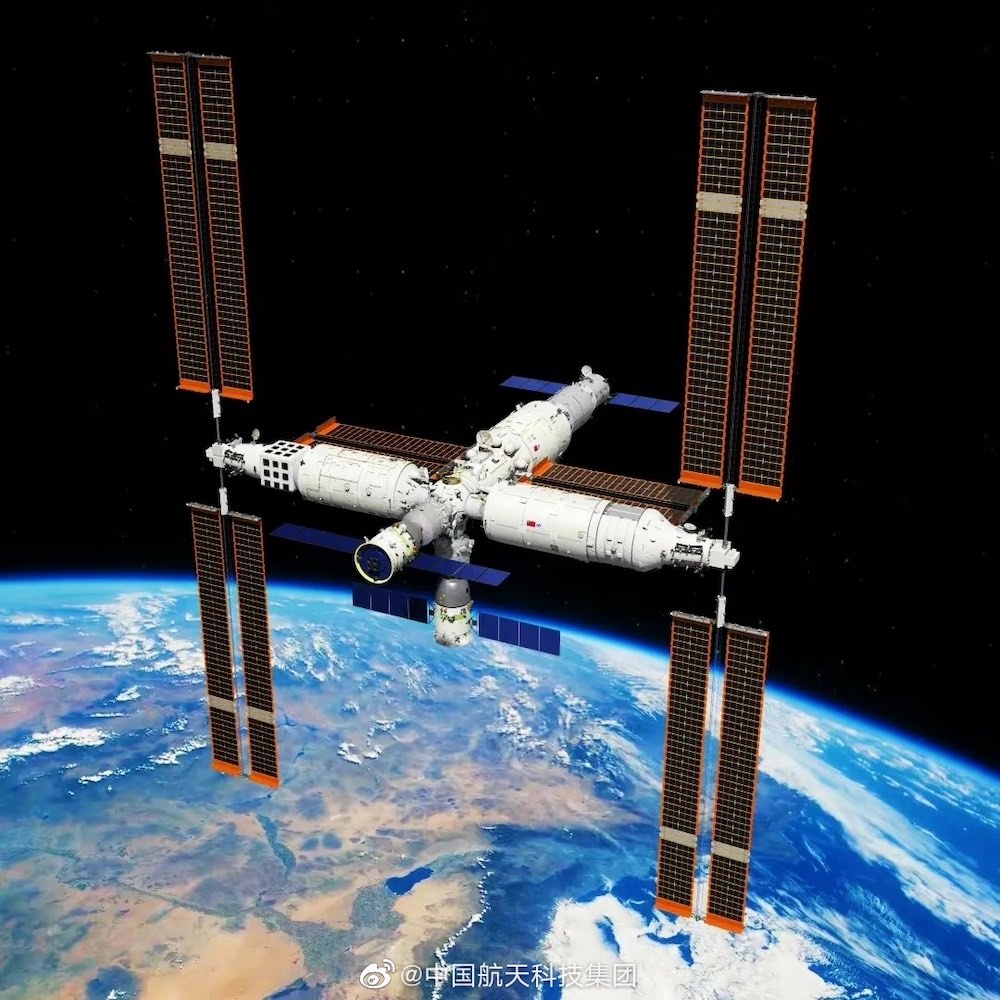
Chinese ground teams rolled the 191-foot-tall (58-meter) Long March 2F rocket to the launch pad Nov. 21 in preparation for the Shenzhou 15 mission. Gantry arms enclosed the launcher as technicians completed final processing and inspections on the rocket. Loading of several hundred tons of toxic hydrazine and nitrogen tetroxide propellants into the rocket began Monday.
The three astronauts will climb into the Shenzhou 15 crew module about two to three hours before liftoff.
A core stage engine and four strap-on boosters will ignite to generate 1.4 million pounds of thrust, driving the rocket and crew eastward from Jiuquan in pursuit of the Chinese space station. The Long March 2F will consume thousands of gallons of toxic, corrosive propellants to accelerate the 8.5-ton Shenzhou 15 spaceship into orbit.
The second stage of the rocket will deploy the crew craft about 10 minutes into the mission. Moments later, Shenzhou 15 is programmed to unfurl its solar panels to begin producing its own electricity.
The spacecraft will fire thrusters to fine-tune its approach to the Chinese space station, culminating in an automated docking at the Tianhe core module later Tuesday. The astronauts will open hatches and float into the Tianhe core module to begin their work.
“According to the plan, the Shenzhou 15 spacecraft will execute … fast autonomous rendezvous and docking procedures. The spacecraft will dock with the forward port of the Tianhe core module to form a three-module and three-ship combination, which is, by far, the largest configuration of China’s space station with a total mass of near 100 (metric) tons,” Ji said.
Quelle: SN
+++
China recruits new reserve astronauts
China is projected to recruit 12 to 14 new reserve astronauts, and the selection, which started in September, is open, for the first time, to payload experts from Hong Kong and Macao, according to the China Manned Space Agency (CMSA) on Monday.
It will be the fourth batch of the country's reserve astronauts. The preliminary selection is currently in progress. The reexamination and confirmation processes will be followed.
Researchers and teachers from sci-tech institutions, universities, and colleges in Hong Kong and Macao in the field of biomedical engineering, machinery, electronics, material, chemistry, and astronomy enthusiastically applied for the selection, said Ji Qiming, assistant to the CMSA director, at a press conference on Monday.
The selection work in the two regions is running smoothly, as the basic qualifications screening has been completed and the clinical examination is underway, according to the CMSA.
China had selected 18 reserve astronauts as its third batch by October 2020, including seven spacecraft pilots, seven flight engineers, and four payloads experts, among them one female.
The 18 reserve astronauts are required to complete training with more than 400 courses in eight categories. They have now finished all courses and the majority of professional skill training, and some have started targeted drills designed for following space missions, said Ji.
Also, China is carrying out relevant preparations for training international astronauts, Ji added.
Quelle: Xinhua
+++
Int'l science payloads to enter China's space station next year: official
A number of space science application projects jointly selected by China and the United Nations Office for Outer Space Affairs (UNOOSA) or with the European Space Agency (ESA) are being implemented as planned, and related payloads will be launched to get into China's space station for experiments next year, according to the China Manned Space Agency (CMSA) on Monday.
China will also welcome astronauts from other countries to enter its space station to conduct experiments, said Ji Qiming, assistant to the CMSA director, at a press conference.
To explore the unknown universe and develop space technology is the common course of human beings, and international cooperation is the trend of space development, Ji said.
During the development and construction of its space station, China has always adhered to the principles of peaceful utilization, equality, mutual benefit, and common development. It has carried out various exchanges and cooperation with many space agencies and international organizations, Ji said.
After the space station enters the application and development phase, China will continue to adhere to the development concept of openness and sharing, and carry out more and deeper pragmatic cooperation with countries and regions committed to the peaceful utilization of outer space, so that the scientific and technological achievements of China's space station will benefit all mankind, he said.
Many countries have made proposals to send their astronauts to join the flight missions of China's space station, said Ji, adding that China is working on the proposals and carrying out relevant preparations for training international astronauts.
Quelle: Xinhua
+++
China Focus: China discloses tasks of Shenzhou-15 manned space mission
The Shenzhou-15 astronauts will conduct a work handover with the Shenzhou-14 trio in orbit and carry out the verification of long-term residence on China's space station in its three-module configuration, according to the China Manned Space Agency (CMSA) on Monday.
The Shenzhou-15 mission will wrap up the last stage of the space station construction and kick off the first stage of its application and development, said Ji Qiming, assistant to the CMSA director, at a press conference.
During the mission, the Shenzhou-15 crew will also unlock, install and test 15 scientific experiment cabinets, and carry out more than 40 experiments and tests in the fields of space science research and application, space medicine and space technology.
They will conduct extravehicular activities (EVAs) three to four times and complete the installation of the Mengtian lab module extended pump sets and the exposure payload platform, said Ji.
The crew will verify the exit mode of the cargo airlock cabin of the Mengtian module, and cooperate with the ground to complete six cargo exit tasks, said Ji.
They will perform regular platform testing, maintenance and space station affairs management.
In addition, the Shenzhou-15 crew will carry out in-orbit health protection exercises, training and drills, Ji added.
The currently in-orbit Shenzhou-14 crew are preparing for the arrival of the Shenzhou-15 crew. Before the historic meeting, the Shenzhou-14 trio need to set the space station to a six-person in-orbit mode, said Ji.
During the rotation of the two groups, they will complete a work handover concerning the status of the space station combination and materials, as well as the experimental projects.
Launched on June 5 this year, the Shenzhou-14 crew have worked in orbit for 176 days. They cooperated with ground control to complete the assembly and construction of the space station's T-shape structure.
With the Shenzhou-15 crew to be in space soon, there will be a total of 12 astronauts on four missions working for the in-orbit construction of China's space station, according to Ji.
The Shenzhou-15 manned spaceship will be launched at 11:08 p.m. Tuesday (Beijing Time) from the Jiuquan Satellite Launch Center in northwest China.
Quelle: Xinhua
+++
China Focus: China unveils Shenzhou-15 crew for space station mission
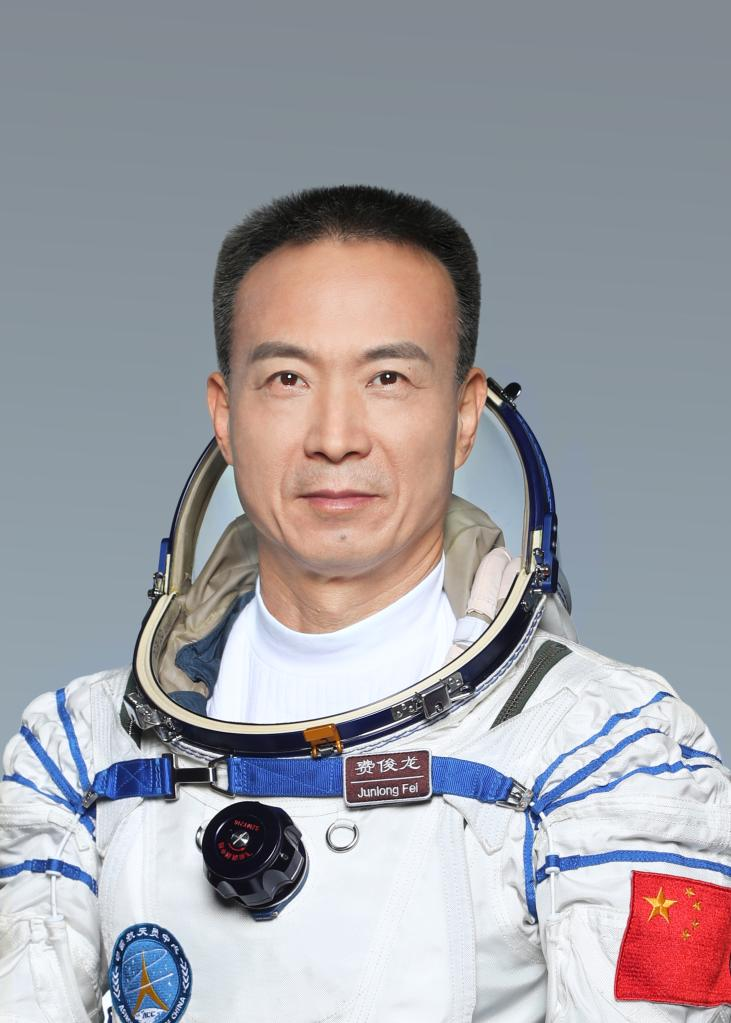
This undated photo shows Fei Junlong, one of the three astronauts who will carry out the Shenzhou-15 spaceflight mission. Chinese astronauts Fei Junlong, Deng Qingming and Zhang Lu will carry out the Shenzhou-15 spaceflight mission, and Fei will be the commander, the China Manned Space Agency announced at a press conference on Monday. (Xinhua)
Chinese astronauts Fei Junlong, Deng Qingming and Zhang Lu will carry out the Shenzhou-15 spaceflight mission, and Fei will be the commander, the China Manned Space Agency (CMSA) announced at a press conference on Monday.
Fei once participated in the Shenzhou-6 spaceflight mission and both Deng and Zhang are newcomers to space, according to Ji Qiming, assistant to the CMSA director.
"I'm very proud to be on a mission again. I'm very excited to be stationed in China's space station. I'm proud of my great motherland," said Fei when he met the press for the upcoming mission.
Deng, who became one of China's first 14 trainee astronauts 24 years ago, had offered support for several space flights as a backup. "I will cherish this opportunity to fly into space and fulfill my duty," said Deng at the press conference.
Zhang was selected as one of China's second batch of astronauts 12 years ago. "I am ready for my first space flight," said he. "I will fly for my personal dream and fly for our nation's dream."
Talking about the upcoming work handover with the Shenzhou-14 crew, Zhang said "we have gifts for them, but we'll keep it a secret for now."
It is the sixth flight mission of China's manned spaceflight program this year and the last one in the construction phase of China's space station, said Ji. With the Shenzhou-15 crew to be in space soon, there will be a total of 12 astronauts on four missions working for the in-orbit construction of China's space station.
During their stay in orbit, the Shenzhou-15 crew will rotate with the Shenzhou-14 trio in orbit and witness the arrival of the Tianzhou-6 cargo craft and Shenzhou-16 manned spaceship. They will also have a work handover with the Shenzhou-16 crew in orbit.
He added that the trio will stay in orbit for six months and return to the ground in May next year according to the plan.
During the mission, the Shenzhou-15 crew will carry out verification of long-term residence in China's space station at its three-module configuration. They will also unlock, install and test 15 scientific experiment cabinets, and carry out more than 40 experiments and testing in the fields of space science research and application, space medicine, and space technology.
They will conduct extravehicular activities (EVAs) three to four times and complete the installation of the Mengtian lab module extended pump sets and the exposure payload platform, said Ji.
The crew will also verify the exit mode of the cargo airlock cabin of the Mengtian module, and cooperate with the ground to complete six cargo exit tasks. They will perform regular platform testing, maintenance, and space station affairs management, said Ji.
The Shenzhou-15 manned spaceship is scheduled to be launched at 11:08 p.m. Tuesday (Beijing Time) from the Jiuquan Satellite Launch Center in northwest China. The launch will be carried out with a Long March-2F carrier rocket.
After entering orbit, the Shenzhou-15 spaceship will make a fast, automated rendezvous and dock with the front port of the space station's core module, Tianhe. The space station will then be expanded to its largest configuration with three modules and three spaceships, having a total mass of nearly 100 tonnes, Ji said.
The three modules refer to Tianhe and two lab modules Wentian and Mengtian, and the three spaceships the cargo craft Tianzhou-5 and two spaceships Shenzhou-15 and Shenzhou-14.
Also on Monday, the CMSA announced that a number of space science application projects jointly selected by China and the United Nations Office for Outer Space Affairs or with the European Space Agency are being implemented as planned, and related payloads will be launched to get into China's space station for experiments next year.
China will also welcome astronauts from other countries to enter its space station to conduct experiments, said Ji at the press conference. ■
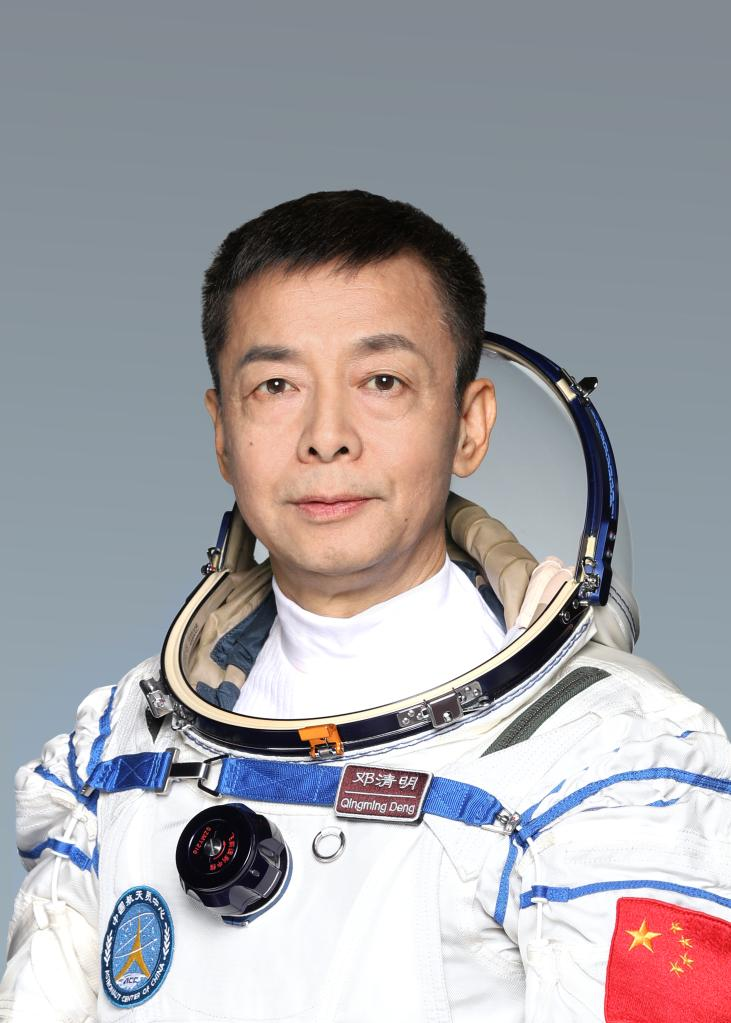
This undated photo shows Deng Qingming, one of the three astronauts who will carry out the Shenzhou-15 spaceflight mission. Chinese astronauts Fei Junlong, Deng Qingming and Zhang Lu will carry out the Shenzhou-15 spaceflight mission, and Fei will be the commander, the China Manned Space Agency announced at a press conference on Monday. (Xinhua)
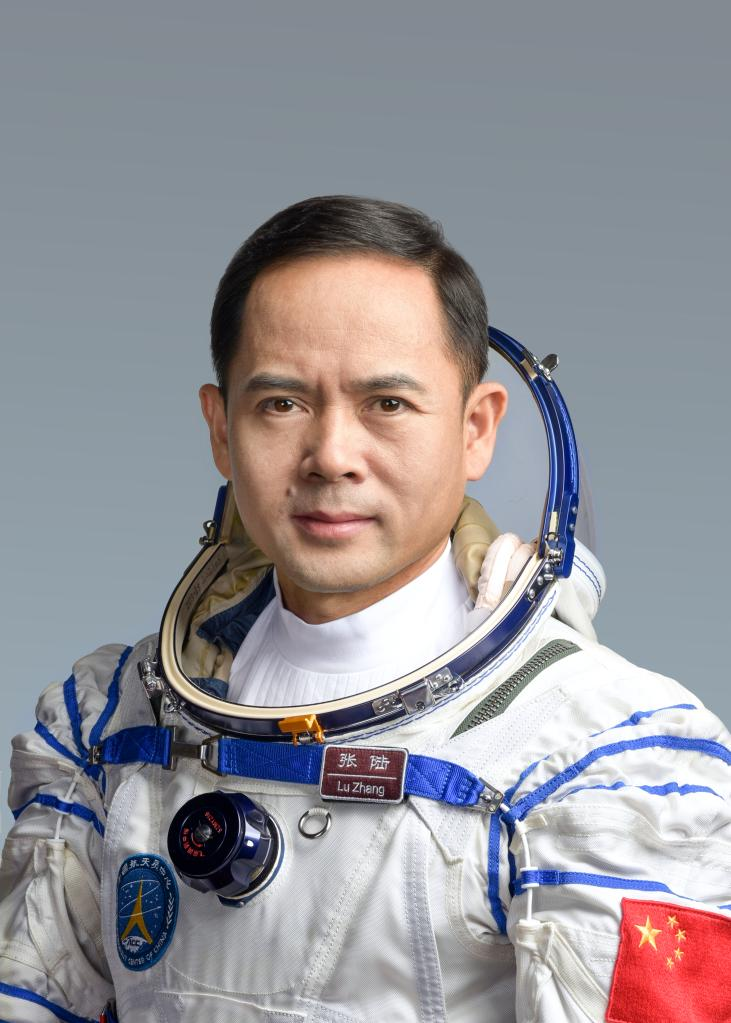
This undated photo shows Zhang Lu, one of the three astronauts who will carry out the Shenzhou-15 spaceflight mission. Chinese astronauts Fei Junlong, Deng Qingming and Zhang Lu will carry out the Shenzhou-15 spaceflight mission, and Fei will be the commander, the China Manned Space Agency announced at a press conference on Monday. (Xinhua)
Quelle: Xinhua
+++
China ready to implement moon landing project
China has made breakthroughs in the development of the new-generation crewed spaceship, new-generation manned carrier rocket, moon lander, and moon landing spacesuit, stepping closer to its moon landing goal, according to the China Manned Space Agency on Monday.
China has completed key technology research and validation of the manned lunar exploration project, forming a moon landing implementation plan with "Chinese characteristics," said Ji Qiming, an assistant to the agency's director, at a press conference ahead of the launch of the Shenzhou-15 manned space mission.
"China's footsteps in space exploration will not stay only in the low-Earth orbit, and we will surely fly further," Ji replied to the question of when China will land on the moon.
"The country is ready to implement the lunar landing project. I believe the dream of landing on the moon will come true in the near future," Ji said.
Quelle: Xinhua
----
Update: 30.11.2022
.
China launches Shenzhou-15 spaceship, aiming for first in-orbit crew rotation
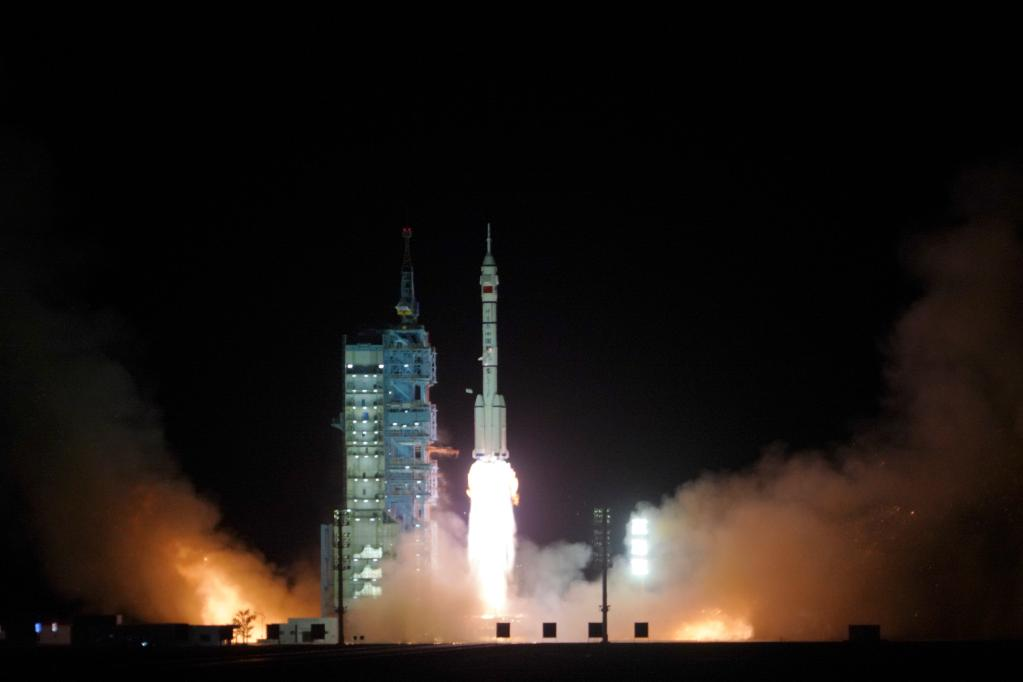
The manned spaceship Shenzhou-15, atop the Long March-2F Y15 carrier rocket, blasts off from the Jiuquan Satellite Launch Center in northwest China, Nov. 29, 2022. (Xinhua/Li Gang)
China launched the manned spaceship Shenzhou-15 on Tuesday night, with three astronauts onboard due to meet with their colleagues on the country's space station and conduct a work handover.
The spaceship, atop the Long March-2F Y15 carrier rocket, blasted off from the Jiuquan Satellite Launch Center in northwest China at 11:08 p.m. (Beijing Time), according to the China Manned Space Agency (CMSA).
About 10 minutes after the launch, Shenzhou-15 separated from the rocket and entered its designated orbit. The crew members are in good shape and the launch is a complete success, the CMSA declared.
After entering orbit, the Shenzhou-15 spaceship will make a fast, automated rendezvous and dock with the space station combination.
The Shenzhou-15 astronauts will, for the first time in China's space history, conduct an in-orbit rotation with the Shenzhou-14 crew, who were sent to the space station in June, said the CMSA.
The rotation can verify the feasibility of the regular rotation mode that will follow, according to Gao Xu, a senior spaceship designer at the China Academy of Space Technology.
SIX ASTRONAUTS IN ORBIT
The Shenzhou-14 crew plan to complete the in-orbit work handover in a week, and then return to the Dongfeng landing site in north China's Inner Mongolia Autonomous Region, said Ji Qiming, assistant to the CMSA director, at a press conference on Monday.
During the rotation of the two groups, they will complete a work handover concerning the status of the space station combination and materials, as well as the experimental projects. Meanwhile, the Shenzhou-14 crew will continue to make relevant preparations for their return.
With six astronauts in orbit, it's a challenge to allocate resources such as space, equipment and materials rationally for more efficient utilization, according to the China Astronaut Research and Training Center.
There are two sets of kitchen equipment in orbit, allowing the six to prepare a meal at the same time and share food with each other. In addition, two modules of the space station are equipped with two sanitary areas and six sleeping areas, all of which can be used independently, said the center.
The processing capacity of the environmental control and life support system will also be increased to meet the maximum demand from six people.
During the rotation, the information of the two manned spaceships will be transmitted through different lines for exclusiveness and accuracy, Gao said.
In addition, an emergency evacuation strategy based on the situation of two berthing spaceships has been worked out to ensure the safety of astronauts, Gao said.
INTENSIVE TASKS
The Shenzhou-15 mission will wrap up the last stage of the space station construction and kick off the first stage of its application and development, Ji said.
During their six-month mission, the Shenzhou-15 crew will carry out tests related to long-term residence in China's space station at its three-module configuration, Ji said.
The crew will also unlock, install and test 15 scientific experiment cabinets, and carry out more than 40 experiments and tests in the fields of space science research and application, space medicine and space technology, Ji said.
They will conduct extravehicular activities (EVAs) three to four times and complete the installation of the Mengtian lab module extended pump sets and the exposure payload platform, Ji said.
The astronauts need to master the operation skills of the new extravehicular spacesuits, node cabin of the Tianhe module, mechanical arms and other facilities and equipment as well as relevant emergency fault dealing methods, according to the China Astronaut Research and Training Center. These requirements call for high standards in terms of physical strength and extravehicular operational skills.
The crew will also verify the exit mode of the cargo airlock cabin of the Mengtian module, and cooperate with the ground to complete six cargo exit tasks. They will perform regular platform testing, maintenance, and space station affairs management, Ji said.
In addition, the Shenzhou-15 crew will carry out in-orbit health protection exercises, training and drills, Ji added.
It is the 27th flight mission since the country's manned space program was approved and initiated, and the fourth crewed mission for China's space station project.
The success of the launch marks the completion of all 12 launch missions planned in the key technology verification and construction phases of the space station.
The space station combination is now in a stable status with all equipment functioning well, ready for the rendezvous-and-docking of Shenzhou-15 and the following crew rotation.
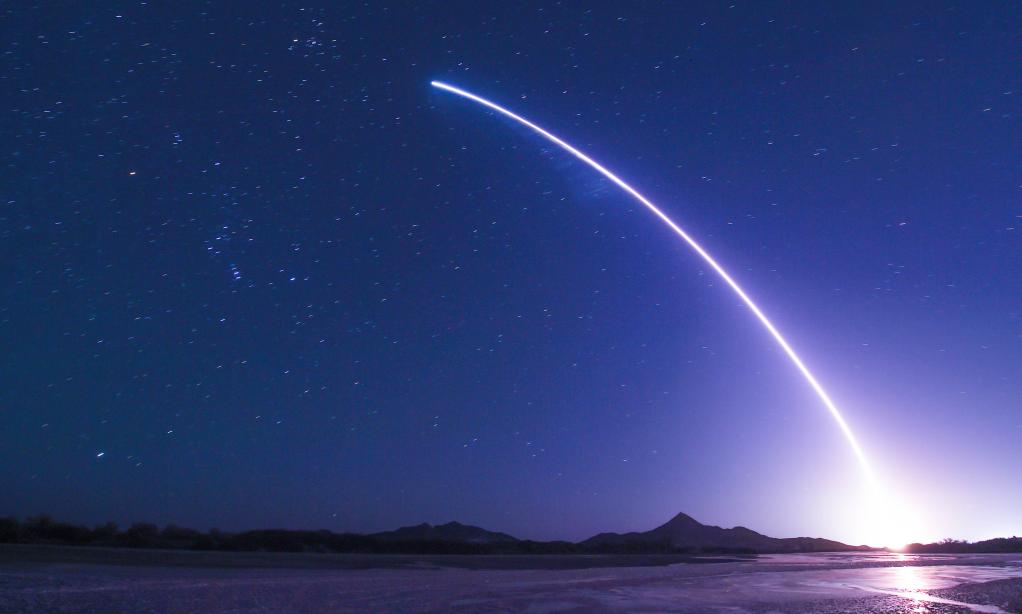
The manned spaceship Shenzhou-15, atop the Long March-2F Y15 carrier rocket, blasts off from the Jiuquan Satellite Launch Center in northwest China, Nov. 29, 2022. (Xinhua/Lian Zhen)
Quelle: Xinhua
+++
China's Shenzhou-15 manned spaceship docks with space station combination
China's Shenzhou-15 manned spaceship successfully docked with the space station combination early on Wednesday, according to the China Manned Space Agency (CMSA).
The spaceship, launched on Tuesday night, conducted a fast automated rendezvous and docked with the front port of the space station's Tianhe module at 5:42 a.m. Wednesday (Beijing Time), said the CMSA.
The whole process took approximately 6.5 hours, the CMSA said.
The astronaut trio aboard Shenzhou-15 will then enter the Tianhe module and the three astronauts of the Shenzhou-14 crew have gotten ready for the arrival of the Shenzhou-15 crew, it said.
It is the first time that Chinese astronauts aboard the space station have seen the visit of a crewed spaceship, according to the CMSA.
The spaceship, atop the Long March-2F Y15 carrier rocket, blasted off from the Jiuquan Satellite Launch Center in northwest China at 11:08 p.m. Tuesday (Beijing Time). ■

This image captured at the Jiuquan Satellite Launch Center in northwest China shows the manned spaceship Shenzhou-15 successfully docking with the front port of the space station's Tianhe module on Nov. 30, 2022. China's Shenzhou-15 manned spaceship successfully docked with the space station combination early on Wednesday, according to the China Manned Space Agency (CMSA).
The spaceship, launched on Tuesday night, conducted a fast automated rendezvous and docked with the front port of the space station's Tianhe module at 5:42 a.m. Wednesday (Beijing Time), said the CMSA.
The whole process took approximately 6.5 hours, the CMSA said. (Xinhua/Guo Zhongzheng)
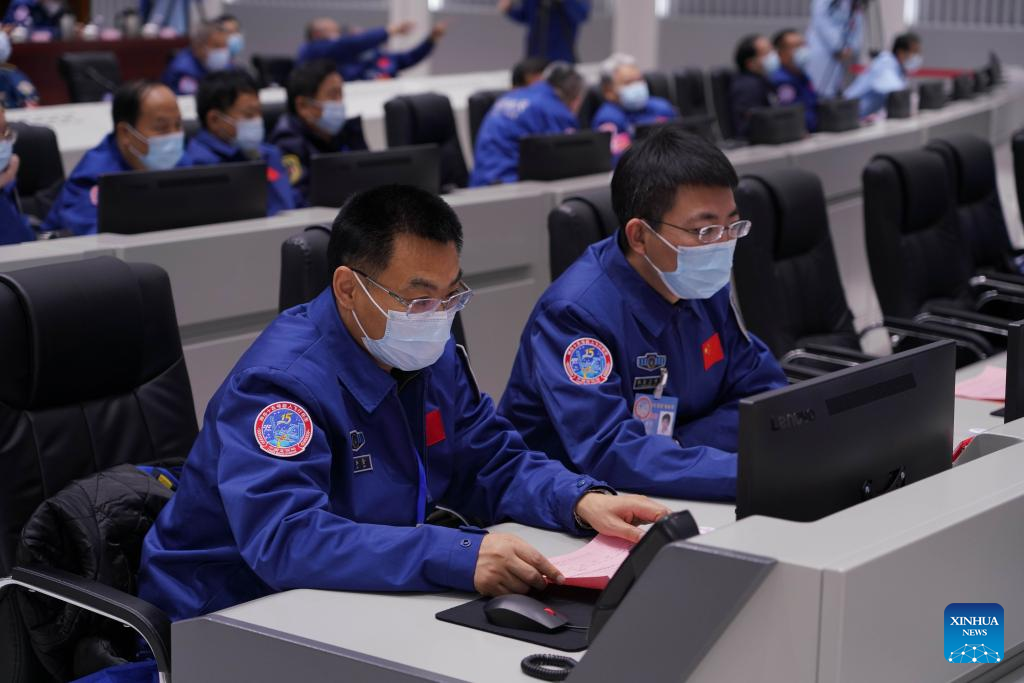
Technical personnel monitor China's Shenzhou-15 manned spaceship conducting a fast automated rendezvous and docking with the space station's Tianhe module at the Jiuquan Satellite Launch Center in northwest China, Nov. 30, 2022. China's Shenzhou-15 manned spaceship successfully docked with the space station combination early on Wednesday, according to the China Manned Space Agency (CMSA).
The spaceship, launched on Tuesday night, conducted a fast automated rendezvous and docked with the front port of the space station's Tianhe module at 5:42 a.m. Wednesday (Beijing Time), said the CMSA.
The whole process took approximately 6.5 hours, the CMSA said. (Photo by Ge Lixin/Xinhua)
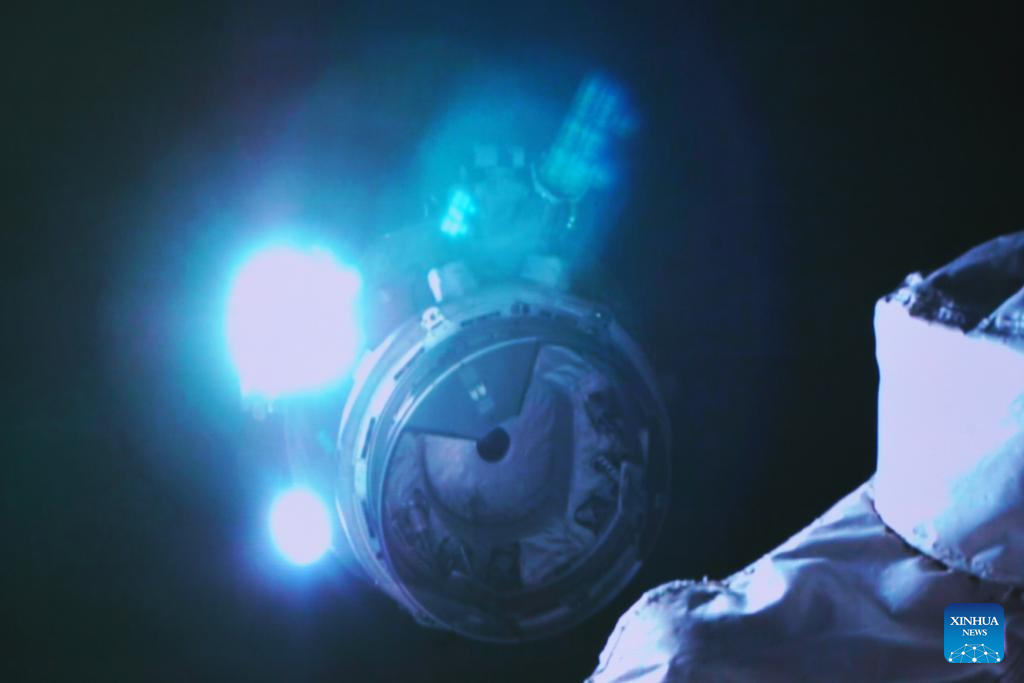
This image captured at the Jiuquan Satellite Launch Center in northwest China shows the manned spaceship Shenzhou-15 conducting a fast automated rendezvous and docking with the space station's Tianhe module on Nov. 30, 2022. China's Shenzhou-15 manned spaceship successfully docked with the space station combination early on Wednesday, according to the China Manned Space Agency (CMSA).
The spaceship, launched on Tuesday night, conducted a fast automated rendezvous and docked with the front port of the space station's Tianhe module at 5:42 a.m. Wednesday (Beijing Time), said the CMSA.
The whole process took approximately 6.5 hours, the CMSA said. (Xinhua/Guo Zhongzheng)
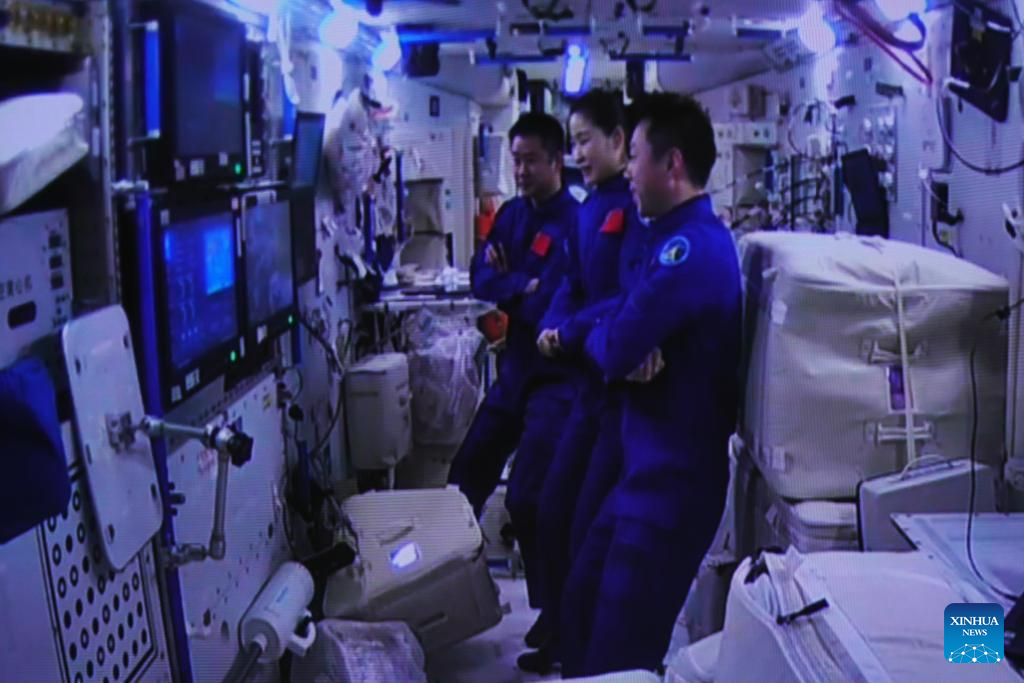
This image captured at the Jiuquan Satellite Launch Center in northwest China shows the crew of China's Shenzhou-14 manned spaceship observing the Shenzhou-15 spaceship conducting a fast automated rendezvous and docking with the space station's Tianhe module on Nov. 30, 2022. China's Shenzhou-15 manned spaceship successfully docked with the space station combination early on Wednesday, according to the China Manned Space Agency (CMSA).
The spaceship, launched on Tuesday night, conducted a fast automated rendezvous and docked with the front port of the space station's Tianhe module at 5:42 a.m. Wednesday (Beijing Time), said the CMSA.
The whole process took approximately 6.5 hours, the CMSA said. (Xinhua/Guo Zhongzheng)
Quelle: Xinhua
+++
China's six astronauts in two missions make historic gathering in space
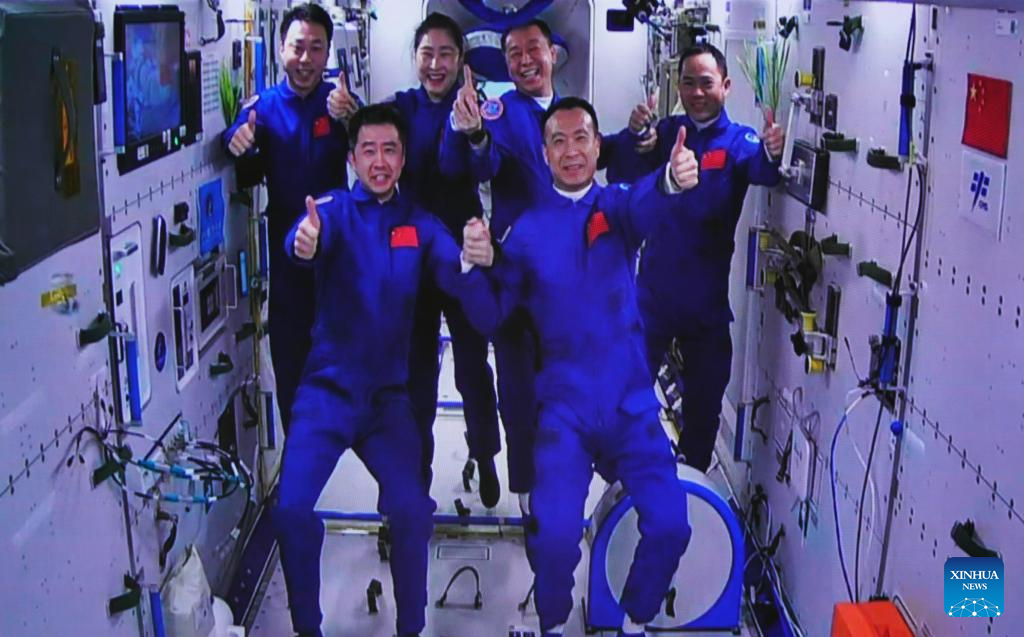
This image captured at the Jiuquan Satellite Launch Center in northwest China shows the Shenzhou-15 and Shenzhou-14 crew taking a group picture with their thumbs up after a historic gathering in space on Nov. 30, 2022.
The three astronauts aboard China's Shenzhou-15 spaceship entered the country's space station and met with another astronaut trio on Wednesday, a historic gathering that added the manpower at the in-orbit space lab to six for the first time.
Chen Dong, the commander of the Shenzhou-14 crew, opened the hatch at 7:33 a.m. (Beijing Time). The three space station occupants greeted the new arrivals with warm hugs and then they took a group picture with their thumbs up, shouting in chorus -- "China's space station is always worth looking forward to." (Xinhua/Guo Zhongzheng)
The three astronauts aboard China's Shenzhou-15 spaceship entered the country's space station and met with another astronaut trio on Wednesday, a historic gathering that added the manpower at the in-orbit space lab to six for the first time.
Chen Dong, the commander of the Shenzhou-14 crew, opened the hatch at 7:33 a.m. (Beijing Time). The three space station occupants greeted the new arrivals with warm hugs and then they took a group picture with their thumbs up, shouting in chorus -- "China's space station is always worth looking forward to."
The space reunion kicked off the first in-orbit crew rotation in China's space station, according to the China Manned Space Agency (CMSA).
The six astronauts are projected to live and work together for about five days to complete planned tasks and handover work, said the CMSA. ■
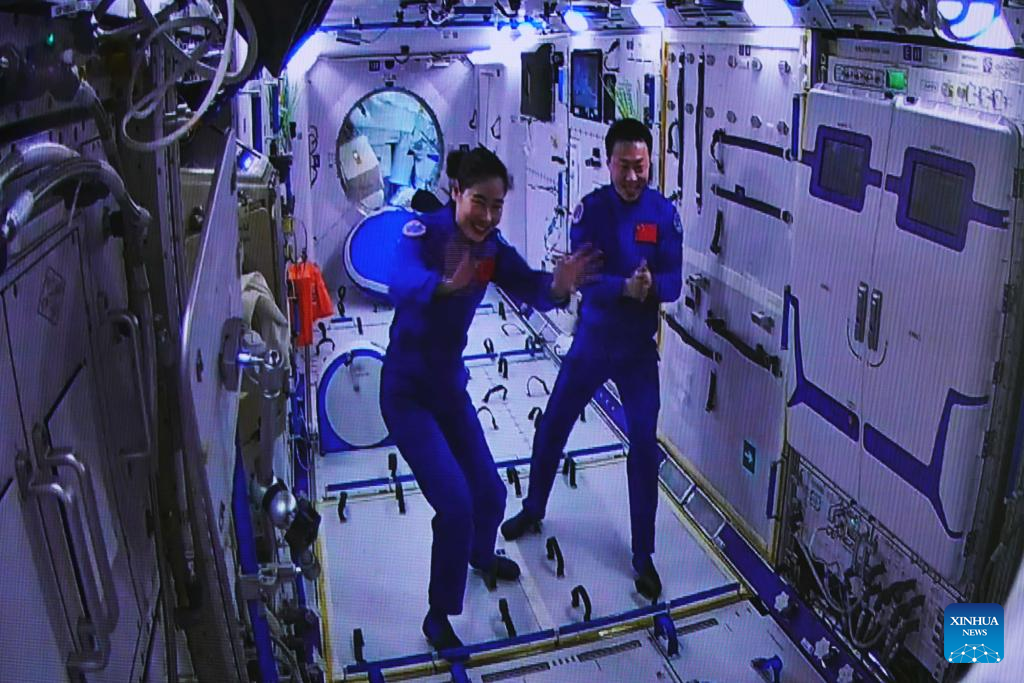
This image captured at the Jiuquan Satellite Launch Center in northwest China shows the Shenzhou-14 astronauts Liu Yang and Cai Xuzhe greeting the Shenzhou-15 crew at the Wentian lab on Nov. 30, 2022.
The three astronauts aboard China's Shenzhou-15 spaceship entered the country's space station and met with another astronaut trio on Wednesday, a historic gathering that added the manpower at the in-orbit space lab to six for the first time.
Chen Dong, the commander of the Shenzhou-14 crew, opened the hatch at 7:33 a.m. (Beijing Time). The three space station occupants greeted the new arrivals with warm hugs and then they took a group picture with their thumbs up, shouting in chorus -- "China's space station is always worth looking forward to." (Xinhua/Guo Zhongzheng)
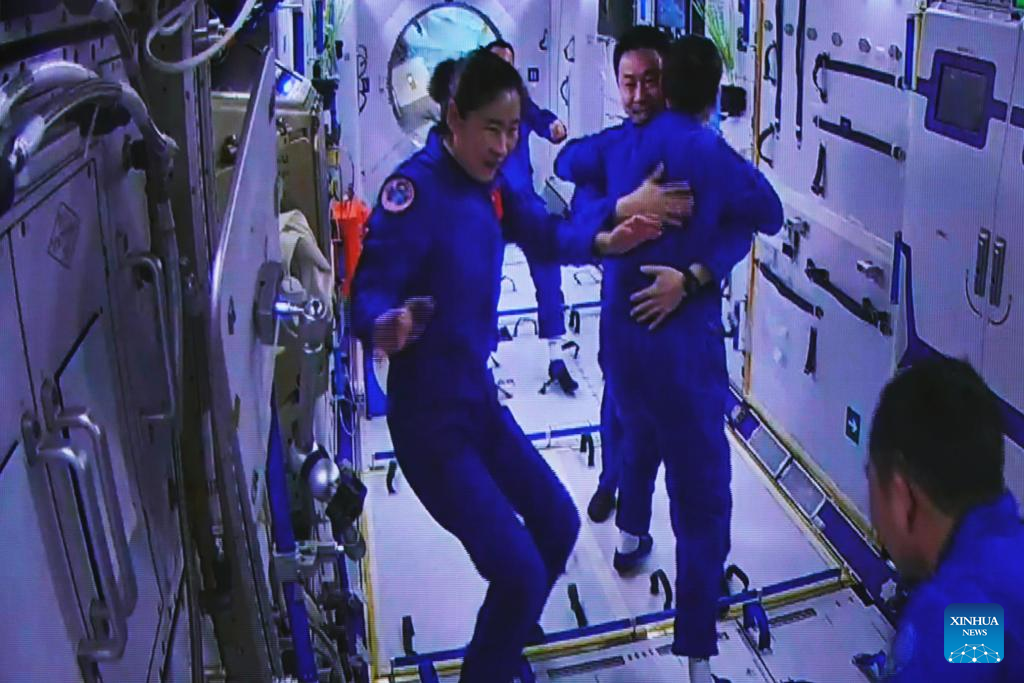
This image captured at the Jiuquan Satellite Launch Center in northwest China shows the Shenzhou-14 astronauts Liu Yang and Cai Xuzhe greeting the Shenzhou-15 crew at the Wentian lab on Nov. 30, 2022.
The three astronauts aboard China's Shenzhou-15 spaceship entered the country's space station and met with another astronaut trio on Wednesday, a historic gathering that added the manpower at the in-orbit space lab to six for the first time.
Chen Dong, the commander of the Shenzhou-14 crew, opened the hatch at 7:33 a.m. (Beijing Time). The three space station occupants greeted the new arrivals with warm hugs and then they took a group picture with their thumbs up, shouting in chorus -- "China's space station is always worth looking forward to." (Xinhua/Guo Zhongzheng)
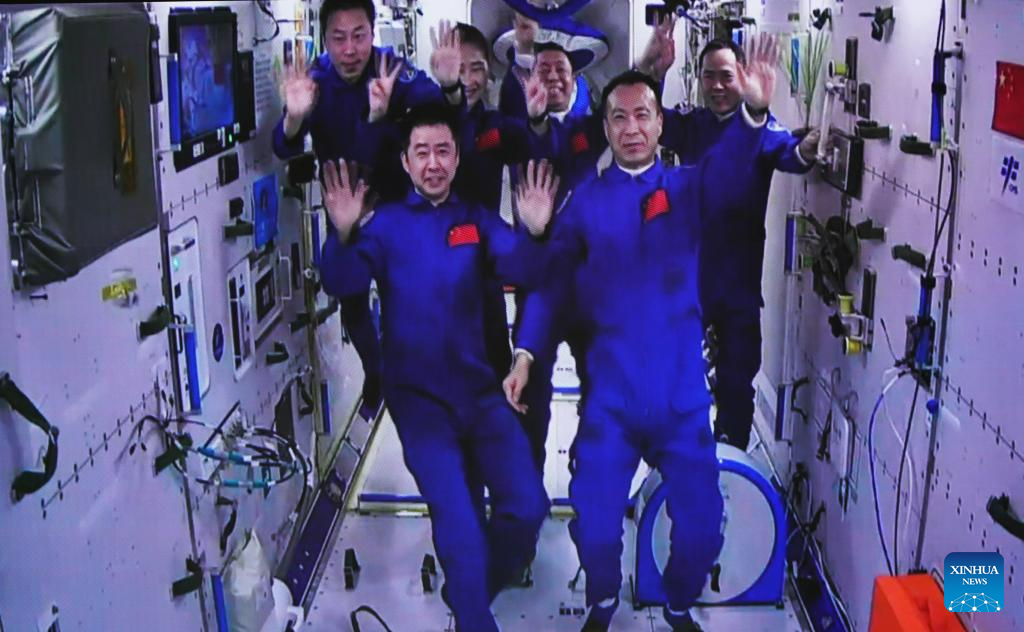
This image captured at the Jiuquan Satellite Launch Center in northwest China shows the Shenzhou-15 and Shenzhou-14 crew waving after a historic gathering in space on Nov. 30, 2022.
The three astronauts aboard China's Shenzhou-15 spaceship entered the country's space station and met with another astronaut trio on Wednesday, a historic gathering that added the manpower at the in-orbit space lab to six for the first time.
Chen Dong, the commander of the Shenzhou-14 crew, opened the hatch at 7:33 a.m. (Beijing Time). The three space station occupants greeted the new arrivals with warm hugs and then they took a group picture with their thumbs up, shouting in chorus -- "China's space station is always worth looking forward to." (Xinhua/Guo Zhongzheng)
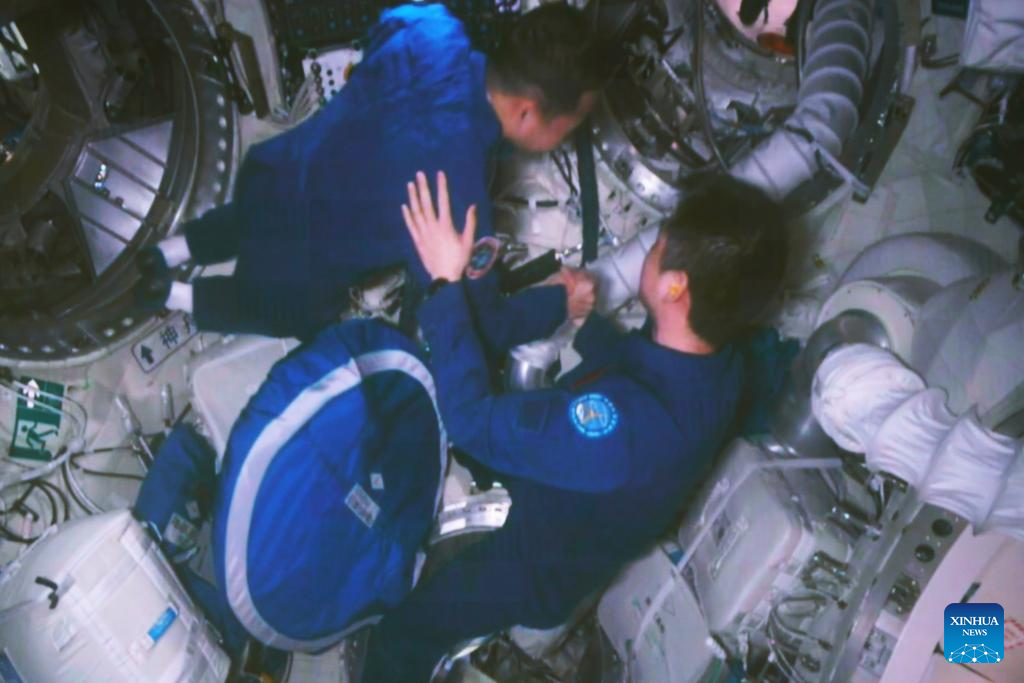
This image captured at the Jiuquan Satellite Launch Center in northwest China shows Chen Dong, the commander of the Shenzhou-14 crew, greeting the Shenzhou-15 crew at the airlock cabin of the space station's Tianhe module on Nov. 30, 2022.
The three astronauts aboard China's Shenzhou-15 spaceship entered the country's space station and met with another astronaut trio on Wednesday, a historic gathering that added the manpower at the in-orbit space lab to six for the first time.
Chen Dong, the commander of the Shenzhou-14 crew, opened the hatch at 7:33 a.m. (Beijing Time). The three space station occupants greeted the new arrivals with warm hugs and then they took a group picture with their thumbs up, shouting in chorus -- "China's space station is always worth looking forward to." (Xinhua/Guo Zhongzheng)
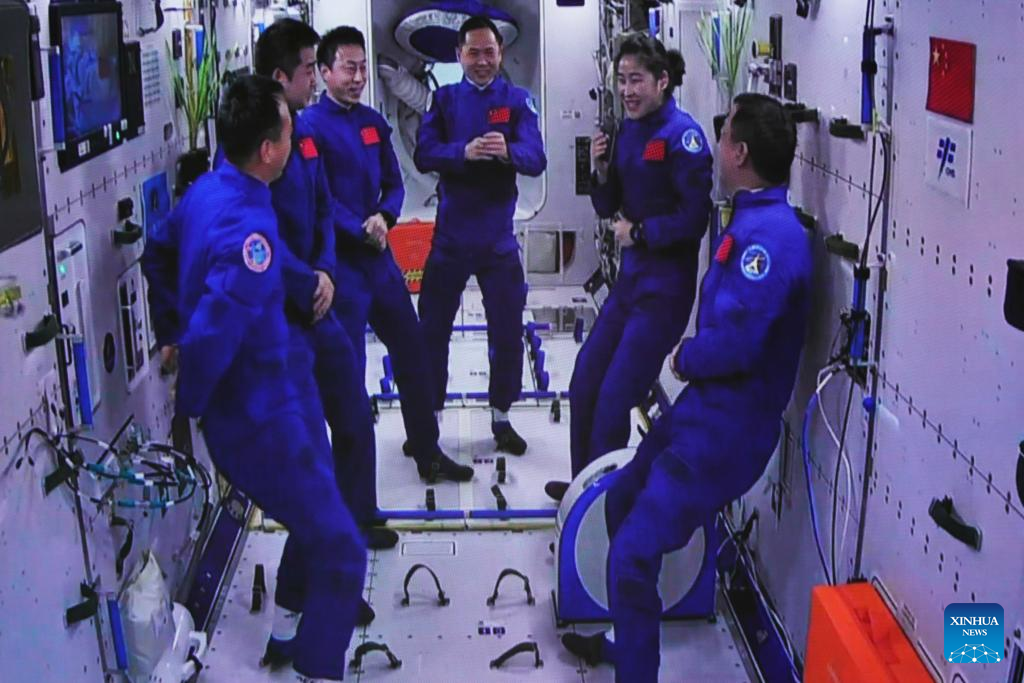
This image captured at the Jiuquan Satellite Launch Center in northwest China shows the Shenzhou-15 and Shenzhou-14 crew communicating after a historic gathering in space on Nov. 30, 2022.
The three astronauts aboard China's Shenzhou-15 spaceship entered the country's space station and met with another astronaut trio on Wednesday, a historic gathering that added the manpower at the in-orbit space lab to six for the first time.
Chen Dong, the commander of the Shenzhou-14 crew, opened the hatch at 7:33 a.m. (Beijing Time). The three space station occupants greeted the new arrivals with warm hugs and then they took a group picture with their thumbs up, shouting in chorus -- "China's space station is always worth looking forward to." (Xinhua/Guo Zhongzheng)
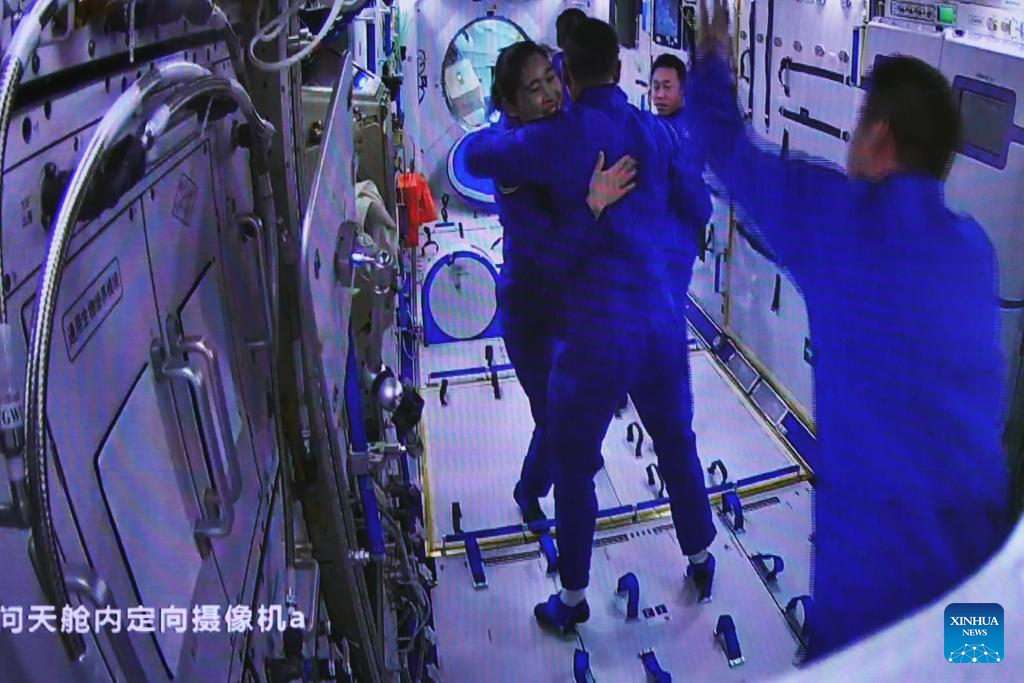
This image captured at the Jiuquan Satellite Launch Center in northwest China shows the Shenzhou-14 astronauts Liu Yang and Cai Xuzhe greeting the Shenzhou-15 crew at the Wentian lab on Nov. 30, 2022.
The three astronauts aboard China's Shenzhou-15 spaceship entered the country's space station and met with another astronaut trio on Wednesday, a historic gathering that added the manpower at the in-orbit space lab to six for the first time.
Chen Dong, the commander of the Shenzhou-14 crew, opened the hatch at 7:33 a.m. (Beijing Time). The three space station occupants greeted the new arrivals with warm hugs and then they took a group picture with their thumbs up, shouting in chorus -- "China's space station is always worth looking forward to." (Xinhua/Guo Zhongzheng)
Quelle: Xinhua
----
Update: 4.12.2022
.
China's Shenzhou 14 astronauts set to return to Earth on Sunday
The three-person crew oversaw a critical construction phase of China's Tiangong space station.
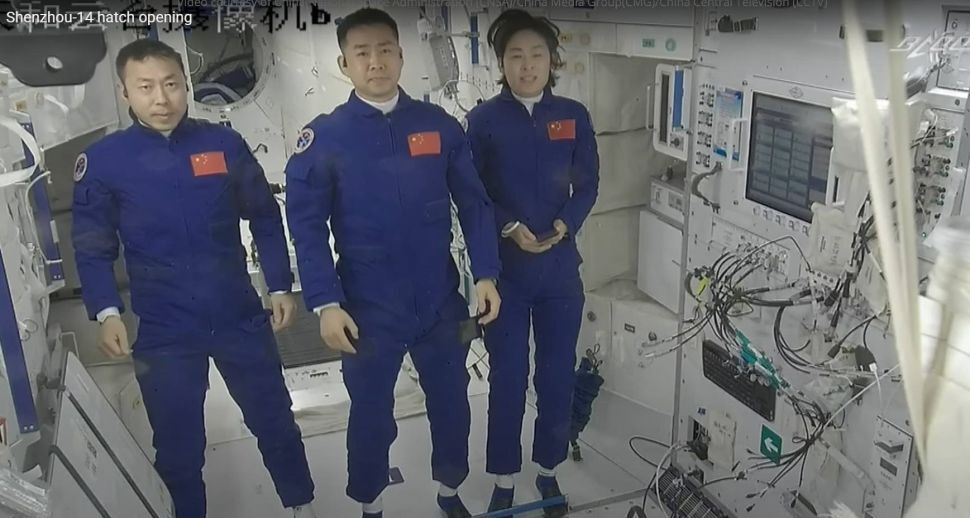
China's Shenzhou 14 astronauts entered the Tiangong space station on June 5, 2022. From left to right: Cai Xuzhe, Chen Dong and Liu Yang. (Image credit: CNSA/CCTV+)
Three astronauts who spent six months in space constructing China's new space station are ready to return home.
Chen Dong, Liu Yang and Cai Xuzhe are scheduled to leave the Tiangong space station and reenter Earth's atmosphere in their Shenzhou 14 spacecraft on Sunday (Dec. 4), according(opens in new tab) to airspace closure notices.
The crew are set to land in their reentry capsule in the Gobi Desert near the Jiuquan Satellite Launch Center at around 7:10 a.m. EST (1210 GMT; 8:10 p.m. Beijing time). A backup window for landing is open 90 minutes, or one orbit of Earth, later.
Ground crews completed rescue and recovery drills on Thursday (Dec. 1) in preparation for the landing, Chinese state media reported(opens in new tab).
The Shenzhou 14 trio launched for the Tianhe space station core module from Jiuquan on June 5 (GMT) and oversaw the arrival of two new modules in orbit, helping to complete the T-shaped Tiangong.
They greeted the incoming Shenzhou 15 crew on Nov. 29, marking the first time China ever had six astronauts in space at the same time. After celebrating the orbital get together, the two crews began preparing for the first Tiangong crew handover and the Shenzhou 14 crew's voyage home.
Quelle: SC
+++
China's Shenzhou-14 astronauts to return to Earth on Dec. 4
China's Shenzhou-14 astronauts, who have completed all their scheduled tasks, will return to Earth on Dec. 4, the China Manned Space Agency (CMSA) said Saturday.
The three astronauts handed over the control of the space station to the Shenzhou-15 crew on Friday evening, completing the country's first in-orbit crew rotation, according to the CMSA.
They will touch down at the Dongfeng landing site in north China's Inner Mongolia Autonomous Region. The landing site is currently making preparations for the return of the three astronauts, the CMSA said.
Quelle: Xinhua
----
Update: 8.12.2022
.
China is considering expanding its Tiangong space station

An image from Tianhe panoramic camera A during the first Shenzhou-13 spacewalk in November 2021. Credit: CMSA/CCTV/Chinese Academy of Sciences
HELSINKI — China is already considering adding modules to its recently-completed Tiangong space station complex, according to a senior space official.
China recently completed construction of its three-module, T-shaped Tiangong space station and conducted its first crew handover, seeing the Shenzhou-14 mission astronauts welcome aboard three new astronauts from Shenzhou-15.
The potential next phase would be adding a new core module, Wang Xiang, commander of the space station system at the China Academy of Space Technology (CAST).
“Following our current design, we can continue to launch an extension module to dock with the forward section of the space station, and the extension module can carry a new hub for docking with the subsequent space vehicles,” Wang told CCTV following the return to Earth of the Shenzhou-14 crew Dec. 4.
Tianhe, the space station core module, was the first piece of the station to be launched back in April 2021. It provides the main propulsion and life support systems and crew quarters for the astronauts on Tiangong and carries a docking hub to facilitate the arrival of spacecraft and further modules.
Wang said that the additional module would provide a larger and more comfortable environment for the astronauts, while providing an environment for better applications of scientific payloads, both inside and outside the module.
A backup or engineering model of the Tianhe core module including docking hubs has been seen in CAST presentations alongside the flight model prior to launch. Models of both the Tianhe and Wentian and Mengtian science modules have also been shown connected for ground testing.
Wang did not state that the plan to expand Tiangong had been approved, but underlined that adding a new core module would open up avenues for more international cooperation in the future, and provide a basis for the next development of the space station.
Yang Liwei, China’s first astronaut to reach space and now deputy chief designer of China’s human spaceflight project, revealed in March this year at the country’s annual political sessions in Beijing that a number of countries have submitted applications to China for astronaut training and joint spaceflight missions. Yang also noted the possibility of tourist flights to Tiangong, while another senior official stated that China is exploring commercial possibilities.
In terms of further ambitions, Wang stated that an extended space station could prove useful for the country’s crewed lunar endeavors, noting that the outpost could be used for testing new generation spacecraft.
China’s original, basic plan for Tiangong is to keep the space station occupied and operational for at least 10 years. A co-orbiting survey space telescope named Xuntian is expected to join Tiangong in orbit no earlier than late 2023.
Quelle: SN
----
Update: 26.12.2022
.
China's space station releases small test satellite into orbit
The satellite's radio and camera can be used by amateur radio operators on the ground.
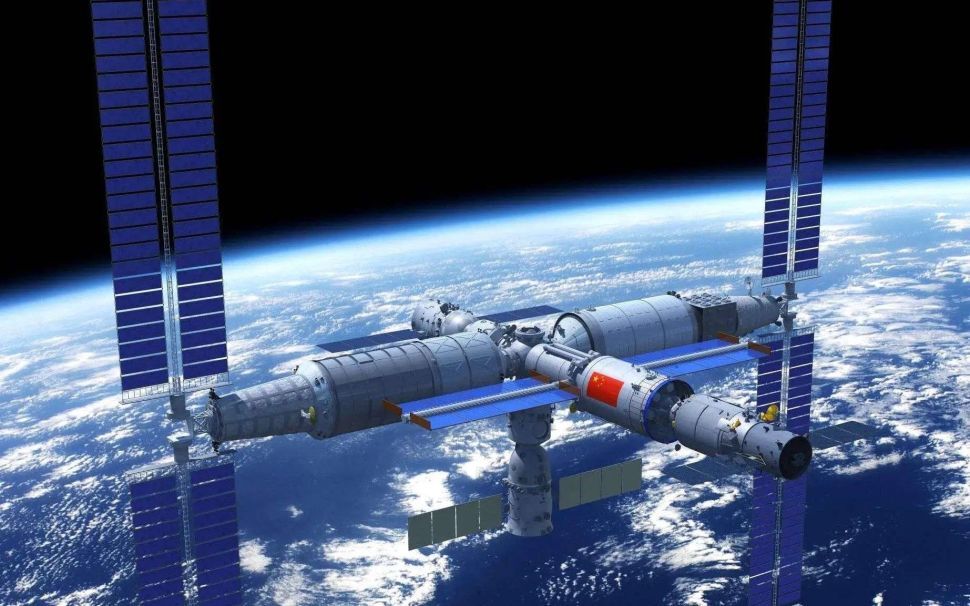
China has released a small test satellite into orbit from its recently completed Tiangong space station.
The satellite was released from a deployer on the Tianzhou 5 cargo ship, which is currently docked at Tiangong. Tianzhou 5 launched on Nov. 12 with the primary mission of delivering supplies to the space station to support the three Shenzhou 15 mission astronauts but also carried a number of cubesats.
The 26.5-pound (12 kilograms) satellite designated XW-4 (CAS-10) was released at 9:30 p.m. EST on Dec. 17 (0130 GMT on Dec. 18). The small spacecraft, also known as the Macao Student Science Satellite 1, carries both optical camera and radio payloads. These will be available for amateur radio operators on the ground to use for two-way communications and to send instructions for taking images.
The satellite will be used by students in Macao, an autonomous region on the south coast of China, for learning about Earth imaging, radio communication and other spaceflight activities, China Daily reported(opens in new tab), citing China's human spaceflight agency, CMSA.
The cubesat has been cataloged by the U.S. Space Force's 18th Space Defense Squadron, which focuses on space domain awareness. The satellite is in a roughly circular orbit with an average altitude of 239 miles (385 kilometers) above Earth.
While this satellite was released from Tianzhou 5, Mengtian — the third and final space station module making up the Tiangong space station — has a dedicated payload airlock that will allow cubesats to be deployed into orbit with the help of the station's robotic arms.
More satellites are expected to be released from Tiangong in the future, with the possibility of opportunities for international science experiments to fly to, and even from, the space station.
Quelle: SC
----
Update: 9.02.2023
.
Shenzhou-15 taikonauts to perform spacewalk
The Shenzhou-15 taikonauts, who are currently on board the Chinese Tiangong space station, will conduct their first extravehicular activities within the next few days, the China Manned Space Agency announced on Wednesday.
The three-men crew have been living in orbit for 70 days since they entered the space station combination on Nov. 30, 2022. They completed various tasks, including in-orbit crew rotation with the Shenzhou-14 taikonauts, tests of scientific experiment cabinets, and spacecraft equipment inspections.
They also performed medical checks, weightlessness protection workouts and a series of space science experiments.
However, the past two months have not been only about work. The latest space station residents also celebrated the Chinese New Year and held space painting and photo exhibitions, sending New Year greetings to the Chinese people.
According to the agency, the Shenzhou-15 trio are now in good condition, and the space station combination is operating stably. All conditions are in place for the crew's first spacewalk.
The three Shenzhou-15 crew members are Fei Junlong, Deng Qingming and Zhang Lu. Their six-month mission is aimed at wrapping up the last stage of the space station construction and starting the first stage of its application and development.
Quelle: Xinhua
